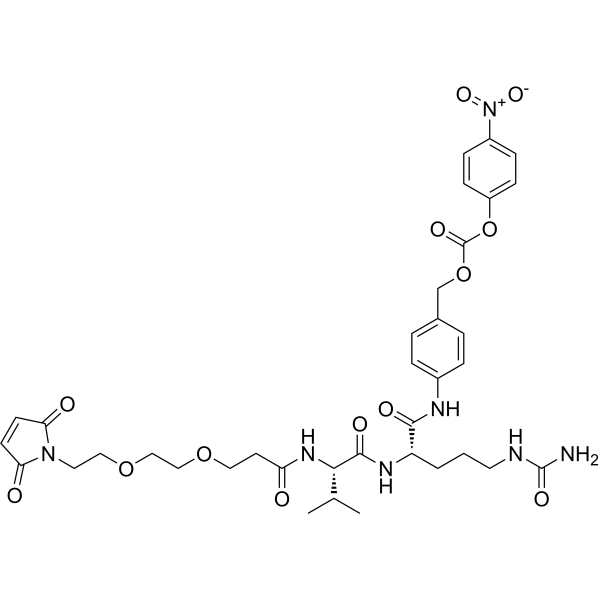Physicochemical Properties
| Molecular Formula | C36H45N7O13 |
| Molecular Weight | 783.781609296799 |
| Exact Mass | 783.307 |
| CAS # | 2395887-69-9 |
| PubChem CID | 139600328 |
| Appearance | White to off-white solid powder |
| LogP | 1 |
| Hydrogen Bond Donor Count | 5 |
| Hydrogen Bond Acceptor Count | 13 |
| Rotatable Bond Count | 24 |
| Heavy Atom Count | 56 |
| Complexity | 1370 |
| Defined Atom Stereocenter Count | 2 |
| SMILES | O=C([C@H](C(C)C)NC(CCOCCOCCN1C(C=CC1=O)=O)=O)N[C@H](C(NC1C=CC(COC(=O)OC2C=CC(=CC=2)[N+](=O)[O-])=CC=1)=O)CCCNC(N)=O |
| InChi Key | UTNZOKGPGOHCAG-IUDBTDONSA-N |
| InChi Code | InChI=1S/C36H45N7O13/c1-23(2)32(41-29(44)15-18-53-20-21-54-19-17-42-30(45)13-14-31(42)46)34(48)40-28(4-3-16-38-35(37)49)33(47)39-25-7-5-24(6-8-25)22-55-36(50)56-27-11-9-26(10-12-27)43(51)52/h5-14,23,28,32H,3-4,15-22H2,1-2H3,(H,39,47)(H,40,48)(H,41,44)(H3,37,38,49)/t28-,32-/m0/s1 |
| Chemical Name | [4-[[(2S)-5-(carbamoylamino)-2-[[(2S)-2-[3-[2-[2-(2,5-dioxopyrrol-1-yl)ethoxy]ethoxy]propanoylamino]-3-methylbutanoyl]amino]pentanoyl]amino]phenyl]methyl (4-nitrophenyl) carbonate |
| HS Tariff Code | 2934.99.9001 |
| Storage |
Powder-20°C 3 years 4°C 2 years In solvent -80°C 6 months -20°C 1 month Note: Please store this product in a sealed and protected environment (e.g. under nitrogen), avoid exposure to moisture. |
| Shipping Condition | Room temperature (This product is stable at ambient temperature for a few days during ordinary shipping and time spent in Customs) |
Biological Activity
| Targets | Protease Cleavable Linker Cleavable Linker |
Solubility Data
| Solubility (In Vitro) | DMSO : 100 mg/mL (127.59 mM) |
| Solubility (In Vivo) |
Solubility in Formulation 1: ≥ 2.67 mg/mL (3.41 mM) (saturation unknown) in 10% DMSO + 40% PEG300 + 5% Tween80 + 45% Saline (add these co-solvents sequentially from left to right, and one by one), clear solution. For example, if 1 mL of working solution is to be prepared, you can add 100 μL of 26.7 mg/mL clear DMSO stock solution to 400 μL PEG300 and mix evenly; then add 50 μL Tween-80 to the above solution and mix evenly; then add 450 μL normal saline to adjust the volume to 1 mL. Preparation of saline: Dissolve 0.9 g of sodium chloride in 100 mL ddH₂ O to obtain a clear solution. Solubility in Formulation 2: 2.67 mg/mL (3.41 mM) in 10% DMSO + 90% (20% SBE-β-CD in Saline) (add these co-solvents sequentially from left to right, and one by one), suspension solution; with ultrasonication. For example, if 1 mL of working solution is to be prepared, you can add 100 μL of 26.7 mg/mL clear DMSO stock solution to 900 μL of 20% SBE-β-CD physiological saline solution and mix evenly. Preparation of 20% SBE-β-CD in Saline (4°C,1 week): Dissolve 2 g SBE-β-CD in 10 mL saline to obtain a clear solution. Solubility in Formulation 3: ≥ 2.67 mg/mL (3.41 mM) (saturation unknown) in 10% DMSO + 90% Corn Oil (add these co-solvents sequentially from left to right, and one by one), clear solution. For example, if 1 mL of working solution is to be prepared, you can add 100 μL of 26.7 mg/mL clear DMSO stock solution to 900 μL of corn oil and mix evenly. (Please use freshly prepared in vivo formulations for optimal results.) |
| Preparing Stock Solutions | 1 mg | 5 mg | 10 mg | |
| 1 mM | 1.2759 mL | 6.3793 mL | 12.7587 mL | |
| 5 mM | 0.2552 mL | 1.2759 mL | 2.5517 mL | |
| 10 mM | 0.1276 mL | 0.6379 mL | 1.2759 mL |
